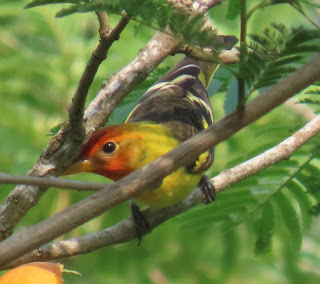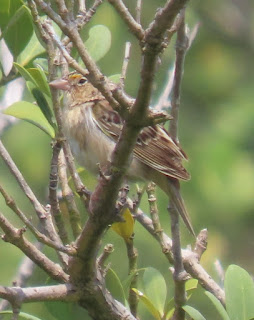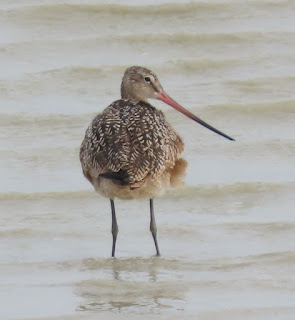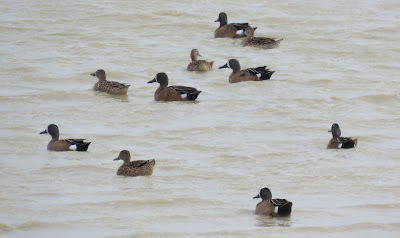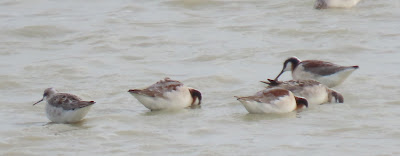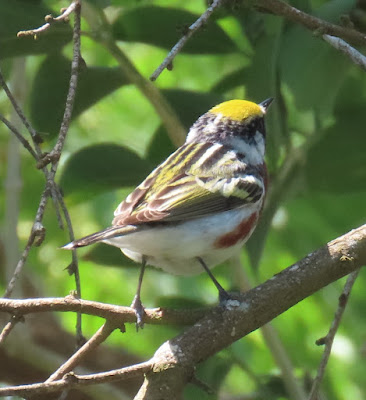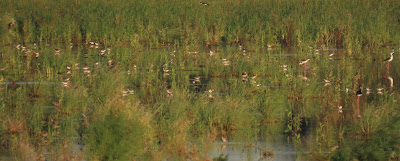25 April 2024
I didn’t hold high
hopes of getting a big list today, as not only were the prevailing winds from
the south (therefore pushing migrants right on through rather than forcing them
to land on the coast), but they were pretty robust at 20-30 mph (with higher
gusts)! But as always, when the date is
set, you do the best you can and just gladly embrace whatever God brings by!
I usually start at
Resaca de la Palma State Park an hour before dawn, as it’s a safe place to sit
and listen for night birds! The good
news was that the main gate was open when I got there (normally I don’t think
they open it until 7:00), but the bad news was that it was probably to allow
the construction crew to get in early: I
had just discovered that morning while getting my on-line permit that they were
resurfacing the tram road, so walking down to the “bridge” at the resaca was
out! But that also allowed me to sit near
the Visitor’s Center where a Rose-throated Becard was reported, and where the
Northern Beardless Tyrannulet usually hangs out (dipped on both, for the
record), so I found a picnic table and enjoyed the dawn chorus (and scared a
few Peccaries who wandered too close in the dark!). I logged Pauraque (1) right as I pulled into
the drive, actually, and White-winged Doves (2) were already going at it. Sneezing Couch’s Kingbirds (3) were next,
followed by several Brown-crested Flycatchers (4), all singing their unique “dawn
songs”. Eventually a McCall’s Screech
Owl (5) trilled, and Mourning Doves (6) broke through the myriad
Whitewings. Cardinals (7) starting
tuning up in the distance, and a White-tipped Dove (8) moaned from the
woods. A distant Altamira Oriole (9) did
his happy whistle while a Mockingbird (10) drowned everything else out when he
started up! A few Green Jays (11) chattered
from the woods, and a Great-tailed Grackle (12) made such a loud noise behind
me that I thought part of the building had fallen off! The sad song of a Clay-colored Thrush (13) wafted
through, as did the rolling song of a Yellow-billed Cuckoo (14). The Olive Sparrows (15) finally woke up with
their bouncing-ball songs, and a Ladder-backed Woodpecker (16) laughed in the
distance, followed immediately by a “chunging” Golden-fronted Woodpecker (17). A Buff-bellied Hummingbird (18) rattled from
the butterfly garden, and could barely pull out the guttural song of a
Long-billed Thrasher (19). Inca Doves (20)
started singing “Bob Hope” from the parking lot, and when it was light enough
to see, a Bronzed Cowbird (21) landed in a nearby tree and did his “Darth Vader”
thing!
About that time the
crew had shown up, and somebody tripped the alarm in the Visitor’s Center, so
since no one seemed in a hurry to shut it off, I figured it was time to move on
(it was almost sunrise, the official “go-to-the-next-place” time anyway)! Picked up a Black-bellied Whistling Duck (22)
and yelling Kiskadee (23) on the way out, and the mesquite savannah along New
Carmen Road added Red-winged Blackbird (24) and a singing Blue Grosbeak (25). Heading north on New Carmen, a Peregrine
Falcon (26) flew overhead, and heard Brown-headed Cowbird (27) and Eastern
Meadowlark (28) on the fly. A pair of
Caracaras (29) were on a power pole, and a Common Nighthawk (30) “beented” unseen
(I actually did have a nighthawk in the park, but he was silent, and it was too
dark to see where the white band landed on the wing, so I was glad to hear this
guy). A House Sparrow (31) chirped at
the buildings at the intersection with Olmito Road, and somewhere along here a
Dickcissel (32) “bratted” overhead.
Heard both Western (33) and Tropical Kingbirds (34) from the car on the
way to the freeway, and added Laughing Gulls (35) flying across the
freeway!
The next stop was the
UTRGV campus in Brownsville, which can be good for parrots, but also had a
couple of rare warblers recently. Approaching
the parking area for Lincoln Park, I heard Chachalacas (36) chorusing in the
nearby woods, and Green Parakeets (37) screeching overhead. A Baltimore Oriole (38) chattered from a
small tree, and at the resaca a Common Yellowthroat (39) sang. A Yellow Warbler (40) also sang and chirped from
one of the trees, while a Carolina Wren (41) sang in the distance. On the way to the bridge a Hooded Oriole (42)
“wheeped” overhead, and House Finches (43) chirped in the trees. The resaca was pretty empty, but a Snowy
Egret (44) did fly right at me, and past the Pollinator Garden (where the
MacGillivray’s Warbler had been seen), an Indigo Bunting (45) and Summer
Tanager (46) sang from some trees near the shoreline (this was also the area
where the lost Fan-tailed Warbler had been hanging out for three months). I added the feral Muscovies (47) to my list,
and on the way back a Tennessee Warbler (48) allowed a look. Just before crossing the street some
Black-crested Titmice (49) started calling and singing, and a Starling (50) fluttered
around back in the parking lot.
Then it was time to
head to South Padre Island, where most of the migration and shorebird action
takes place! On the way to the freeway
added Rock Pigeon (51), and in the Bahia Grande wetlands along SR 48 added
Great Egret (52), Roseate Spoonbill (53), and Great Blue Heron (54) on the
fly. Crossing the Queen Isabella
Causeway added Brown Pelicans (55) diving for lunch, and a stop at the Stripes
added Purple Martins (56) that were nesting in their light pole!
Since the tide was
out, I figured I could drive onto the Flats without rusting out my car (again),
so was able to get close enough to the shorebird flock to actually see what was
out there. Willets (57) called
incessantly, and Barn Swallows (58) were swooping all over. Royal Terns (59) were on a sandbar, along
with a lone Red-breasted Merganser (60).
Sandwich Terns (61) were with the Royals, and a white morph Reddish
Egret (62) came sailing in and danced a little.
Although I could hear the Least Terns calling (63), I had to use the
zoom on my camera to pick out a Black-bellied Plover (64) in the mix. A Tricolored Heron (65) was providing fodder
for a photographer that was on his belly shooting the birds, while Sanderlings (66)
and Short-billed Dowitchers (67) fed further out. Black Skimmers (68) were on another sand bar,
along with a single Ruddy Turnstone (69), with a big flock of Dunlin (70) way
out there that I again needed the zoom to identify! A Neotropic Cormorant (71) batted by, along
with a Ring-billed Gull (72).
With the arrival of
the south winds, the departure of the birders was evident, so I was able to
easily find my favorite parking spot at the top of the “circular area” at the
Convention Centre! This area has several
rows of foliage that provide great cover for migrating birds, and I had barely
stepped out of the car before a Catbird (73) went zipping across! Volunteers had put out seed where three days ago
a Lazuli Bunting (a rare bird for these parts) had joined the Indigos, but this
day only the Indigos were still there, joined by a female Rose-breasted
Grosbeak (74) and a Dickcissel. A
Mottled Duck (75) quacked while I was shooting a female Painted Bunting (76 – never
did see a male this day) and a female Tennessee Warbler that came in close. Spent several minutes at the Drip where I
added the ubiquitous Ruby-throated Hummingbirds (77), and a gentleman there had
just photographed a Western Tanager (an expected migrant but rather rare)! He (the tanager) never returned, so I headed
out to the “back yard” where Peggy Rudman informed me that I “just missed” the
tanager! ☹ Unfortunately, when doing a Birdathon, you
can’t spend too much time waiting for one bird, so I continued perusing the back
yard, getting video of a female Summer Tanager and a Catbird having words over
an orange! A check of the Flats from the
overlook added nothing new (the cormorants were lining the posts, as always),
but a Savannah Sparrow (78) popped up from the grass, so that was worth
it! The Western had returned while I was
gone ☹, so I decided to sit at a
nearby bench within calling distance for five minutes, adding an Orchard Oriole
(79), Gray-cheeked Thrush (80), and Veery (81).
Then a lady I didn’t know called, “The Western Tanager is back!” So I left everything on the bench (except my
camera 😊) and ran over to bag
him for the list (82)! Spent five more
minutes at the Drip where Black-necked Stilts (83) called from the wetland and a
Hooded Warbler (84) came in for a bath.
Headed next door to
the Birding & Nature Center where some friends had reported some great
warblers from the boardwalk there, so I had high hopes! Added a Eurasian Collared Dove (85) calling
in the parking lot, and in their little central pond Mom Mottled Duck had a
little brood of ducklings! What I
assumed was a Mallard (86) in eclipse plumage was preening away, but Javi Gonzales
(the center’s naturalist) bust my balloon when he told me it was actually a
hybrid that’s been there for several years (a true Mallard would have molted
out of eclipse several times over, which this one hadn’t…). I was cheered by several Yellow-headed
Blackbirds (87) over by their big waterfall, as well as a convention of
Rose-breasted Grosbeaks at their tray feeder!
A Cattle Egret (88) was trying to hide in Songbird Alley as I went in to
pay the entrance fee, after which I headed on the boardwalk where most folks
were engrossed in the live alligator demo going on! I squeezed by and rested at the first bird
blind, adding Marbled Godwit (89) to the list amongst the shorebirds already
logged. Further down, their famous Mangrove
Warbler (90 – currently just a race of the Yellow but a good candidate for a
split as they’re so radically different in all respects) was singing away, but
with the wind was content to stay hidden in the mangroves. All the good migrants were being seen in a
sheltered area “around the corner”, but alas, none of the wonderful birds my
friends had seen that morning showed up except for a Warbling Vireo (91) and a
Grasshopper Sparrow (92), which threw me at first, as I only see them in the open
brushlands in winter! In the open fresh
water wetland a Common Gallinule (93) bobbed along while a Green Heron (94) called
unseen. A young White Ibis (95) was
hanging with the whistling ducks, and added Blue-winged Teal (96) and a Coot (97)
in the area where we had a Least Bittern three days before, along with a
Tricolored Heron (who was still in the same spot)! Added nothing new in the East Pond, but a
brilliant Roseate Spoonbill posed as well as another Mottled Duck. A non-Barn Swallow flew overhead that I concluded
was a Northern Rough-winged (98), then spent a few minutes at the Parking Lot
Drip; while not adding anything new, had nice encounters with Catbirds and a
lady Summer Tanager.
On to the Valley Land
Fund Lots on Sheepshead, a famous migrant trap nestled in the midst of a
residential area, where there was a little more action: both Mr. and Mrs. Blackpoll Warbler (99) came
in to an orange almost immediately after stepping out of the car! I told Mary Volz to conjure me up something
good for bird #100, and instead Father Tom pointed out a White-eyed Vireo on
the ground, who eventually came right up to us!
(We all agreed that the Blackpoll would have been a better “#100”… 😊) Lizzy
Cavazos got me on a Black-and-white Warbler (101), after which they admitted
that those wonderful warblers they saw on the boardwalk were seen early that morning
(and it was already afternoon when I got there), which made sense – alas, you
can’t be everywhere first thing in the morning!
There were plenty of already-logged Tennessee Warblers and Baltimore
Orioles about, but I heard an Eastern Wood Pewee (102) while perusing the rest
of the area, which was new. While giving
the north side 15 minutes in the shade of their bench, a Scissor-tailed
Flycatcher (103) got added to the list while an Inca Dove vigorously courted a
female next to me!
The last ditch try for
migrants was the Laguna Vista Nature Trail, so over we went, adding a Turkey
Vulture (104) on the way. This trail has
three blinds with water features, and two of those blinds were already stuffed
with birders, including Father Tom and Danny Salinas and his wife (Mary
actually had to stand outside because there weren’t enough “holes” for her
camera)! The highlight here was a lovely
Magnolia Warbler (105), but a female Orchard Oriole and Olive Sparrow also came
in while I was there. After ten minutes
I headed for the next blind and “changed the guard” with Lizzy – nothing showed
up here except another Ruby-throated Hummer.
Leaving that blind for the next one I was happy to hear a Curve-billed
Thrasher (106) for the list, and a gentleman shooting something in the tree
between us announced that he had a Verdin (107)! The third blind was also stuffed with
photographers, so I was the one to stand outside this time, only the sun was
brutal and nothing was coming in, so I abandoned my post and headed for Palo
Alto Battlefield.
What I didn’t factor
into the itinerary was the fact that they close the gates at 5:00! ☹ The nice
ranger let me rush out onto the trail long enough to add Cassin’s Sparrow (108 –
dipped on the Botteri’s) and rush back before getting locked in! From there headed to the Cannon Road Loop,
which would be the last stop of the day.
The loop actually
consists of several eBird hotspots, but the actual Cannon Road hotspot is a
tract of the Lower Rio Grande Valley NWR where the road passes through a lush
area of Valley woodland. Some Lark
Sparrows (109) were cavorting along the road going in, but the target here was a
Yellow-green Vireo (110) that had been setting up a territory for several
years! Thankfully was able to bag him
right away and get a “proof” recording (they still get flagged as a review
species), but he wouldn’t allow any video.
Tropical Kingbirds were all over, and down the road a bit a Lesser
Goldfinch (111) was calling. Leaving the
woodland for some farmland and Adams Gardens Reservoir I added a calling Killdeer
(112).
I had seen a
low-clearance car barreling down the dike along the reservoir and wondered, “How’d
they get up there?!” when the area had been closed off for years! But lo and behold, the southwestern access to
the dike was open and graded, so up I went, and I was thrilled to see that
indeed the southern dike was open and drivable! Some local birders had reported lots of
Hudsonian Godwits in the “southeast corner” of the reservoir (and at the time
again thinking to myself, “How’d he get out there??”), and there were indeed
lots of birds, so in short order I added Wilson’s Phalarope (113), Lesser
Yellowlegs (114), Least Sandpipers (115), Shovelers (116), Long-billed
Dowitchers (117), and Stilt Sandpipers (118) to the list. Arriving at the famous southeast corner, I
couldn’t find any Hudwits, but there was a nice flock of White Pelicans (119)
along with more spoonbills! It was
getting late, and not having been back there literally in 15 years, I didn’t
want to get myself in a spot where I couldn’t turn around, so I did so at a
reasonably wide spot and headed back to the west end, adding a few fly-by
Franklin’s Gulls (120). I knew the
western and northern dikes were open as Deb Anderson and I had driven them
recently, so I checked the birds along that stretch; nothing new, but there
were still lot of phalaropes, ducks, dowitchers, Black-necked Stilts, and a
nice Marbled Godwit that was vocalizing.
I wanted to check the
sod farms for grasspipers before I lost the sun, so I blasted up to FM 800 and
over to Weaver Road, then down to Hanka Sod, where Horned Larks (121) darted
across the road on the southbound leg.
Didn’t have to wait long to hit pay dirt with several Buff-breasted
Sandpipers (122) working the sod, but they were the only grasspipers to be had
(but the best one, to be sure)! I
continued down Weaver and traversed that section of the NWR tract in hopes of
adding Common Ground Dove and Groove-billed Ani; dipped on those targets, but
got to see a nice Yellow-billed Cuckoo.
Wrapped up the day
with 122 species on my written list; eBird only recognized 119, as I
unashamedly counted the feral Muscovies, the hybrid that I felt was really mostly
Mallard 😊, and the “should be
split” Mangrove Warbler!







